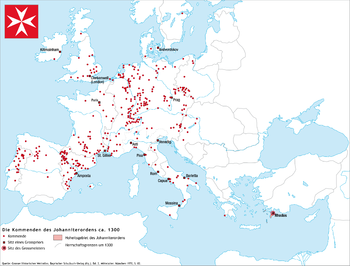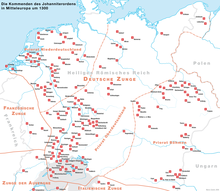
The Teutonic Order is a Catholic religious institution founded as a military society c. 1190 in Acre, Kingdom of Jerusalem. The Order of Brothers of the German House of Saint Mary in Jerusalem was formed to aid Christians on their pilgrimages to the Holy Land and to establish hospitals. Its members have commonly been known as the Teutonic Knights, having historically served as a crusading military order for supporting Catholic rule in the Holy Land and the forced conversion to Catholicism in the Baltics during the Middle Ages, as well as providing military protection for Catholics in Eastern Europe.
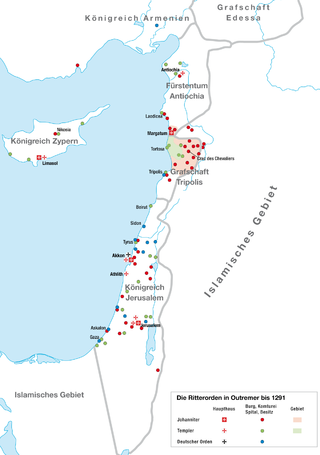
A military order is a Christian religious society of knights. The original military orders were the Knights Templar, the Knights Hospitaller, the Order of Saint James, the Order of Calatrava, and the Teutonic Knights. They arose in the Middle Ages in association with the Crusades, both in the Holy Land, the Baltics, and the Iberian peninsula; their members being dedicated to the protection of pilgrims and Christians, as well as the defence of the Crusader states. They are the predecessors of chivalric orders.
The Russian tradition of the Knights Hospitaller is a collection of charitable organisations claiming continuity with the Russian Orthodox grand priory of the Order of Saint John. The order emerged when Malta was captured by Napoleon in 1798 during the expedition to Egypt. The Grand Master at the stronghold of Malta, Ferdinand von Hompesch, failed to anticipate or prepare for the threat. The Order continued to exist in a diminished form and negotiated with European governments for a return to power. The Emperor of Russia gave shelter to the largest number of Knights in St Petersburg and this gave rise to the Russian tradition of the Knights Hospitaller and recognition within the Russian Imperial Orders. In gratitude the Knights declared Ferdinand von Hompesch deposed and Emperor Paul I was elected as the new Grand Master. The continuous Order was also approved by the Papacy, but due to British fear of Russian taking presence in the Mediterranean and because many knights were Orthodox the Order became de facto the traditional Order but de jure not recognised similar or at par with the formation of the 19th-century Sovereign Military Order of Malta.

The Order of St John, short for Most Venerable Order of the Hospital of Saint John of Jerusalem and also known as St John International, is a British royal order of chivalry constituted in 1888 by royal charter from Queen Victoria and dedicated to St John the Baptist.
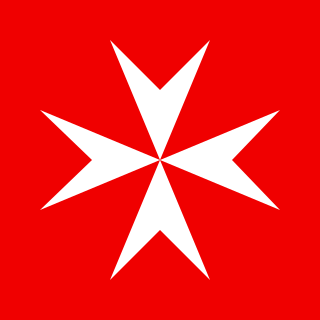
The Bailiwick of Brandenburg of the Chivalric Order of Saint John of the Hospital at Jerusalem, commonly known as the Order of Saint John or the Johanniter Order, is the German Protestant branch of the Knights Hospitaller, the oldest surviving chivalric order, which generally is considered to have been founded at Jerusalem in 1099.
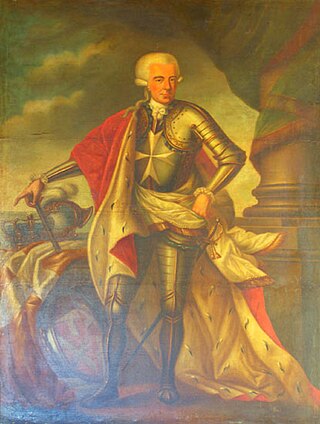
Ferdinand von Hompesch zu Bolheim, O.S.I. was the 71st Grand Master of the Knights Hospitaller, formally the Order of St. John of Jerusalem, by then better known as the Knights of Malta. He was the first German elected to the office. It was under his rule that the Order lost the island of Malta to France, after ruling there since 1530. This effectively marked the end of their sovereignty over an independent state, dating from the time of the Crusades.
The Knights of Justice or Professed Knights, form the first of the three classes of members of the Sovereign Military Order of Malta together with the professed conventual chaplains. They make vows of poverty, chastity, and obedience. According to the Order's Code, "they are religious in all respects and they comply with the universal and particular norms that concern them."

The Knights Templar, full name The United Religious, Military and Masonic Orders of the Temple and of St John of Jerusalem, Palestine, Rhodes and Malta, is a fraternal order affiliated with Freemasonry. Unlike the initial degrees conferred in a regular Masonic Lodge, which only require a belief in a Supreme Being regardless of religious affiliation, the Knights Templar is one of several additional Masonic Orders in which membership is open only to Freemasons who profess a belief in Christianity. One of the obligations entrants to the order are required to declare is to protect and defend the Christian faith. The word "United" in its full title indicates that more than one historical tradition and more than one actual order are jointly controlled within this system. The individual orders 'united' within this system are principally the Knights of the Temple, the Knights of Malta, the Knights of St Paul, and only within the York Rite, the Knights of the Red Cross.
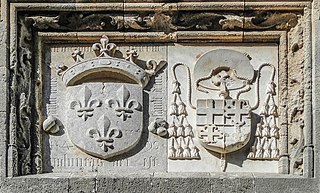
A langue or tongue was an administrative division of the Knights Hospitaller between 1319 and 1798. The term referred to a rough ethno-linguistic division of the geographical distribution of the Order's members and possessions. Each langue was subdivided into Priories or Grand Priories, Bailiwicks and Commanderies. Each langue had an auberge as its headquarters, some of which still survive in Rhodes, Birgu and Valletta.
In the Middle Ages, a commandery was the smallest administrative division of the European landed properties of a military order. It was also the name of the house where the knights of the commandery lived. The word is also applied to the emoluments granted to a commander. They were the equivalent for those orders to a monastic grange. The knight in charge of a commandery was a commander.

The Order of Knights of the Hospital of Saint John of Jerusalem, commonly known as the Knights Hospitaller, was a medieval and early modern Catholic military order. It was founded in the Kingdom of Jerusalem in the 12th century and had headquarters there until 1291, thereafter being based in Kolossi Castle in Cyprus (1302–1310), the island of Rhodes (1310–1522), Malta (1530–1798), and Saint Petersburg (1799–1801).

Johanniter-Unfall-Hilfe e.V., commonly referred to as Die Johanniter, is a voluntary humanitarian organisation affiliated with the Brandenburg Bailiwick of the Order of St John, the German Protestant descendant of the Knights Hospitaller. The organisation was founded in 1952 in Hanover under the leadership of Rudolf Christoph Freiherr von Gersdorff. One of the main reasons for its creation was the rise in injuries and deaths from road traffic accidents. JUH participates in international aid efforts together with its sister organisations in other countries as part of the Johanniter International partnership; it also works with the German Malteser Hilfsdienst, affiliated to the Catholic Sovereign Military Order of Malta. As of 2017 the organisation had 37,000 active volunteers and youth members and around 1,300,000 registered members.
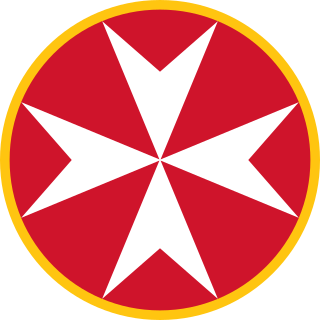
The Alliance of the Orders of Saint John of Jerusalem is a federation of European chivalric orders that share inheritance of the tradition of the medieval military Knights Hospitaller.

Wilhelm Karl Adalbert Erich Detloff Prinz von Preussen was the third son of Prince Oskar of Prussia, and the last surviving grandson of Wilhelm II, the last German Emperor. He was the thirty-sixth Master of Knights (Herrenmeister) of the Protestant Order of Saint John, also known as Der Johanniterorden, as his father's successor and his son's predecessor.
A bailiff was a high official in the Knights Hospitaller who directed one of its bailiwicks abroad or one of the national associations ("tongues") at its headquarters.

Oskar Michael Hans Karl Prinz von Preussen is a member of the House of Hohenzollern, the former ruling house of Germany. He is the thirty-seventh Herrenmeister of the Order of Saint John.
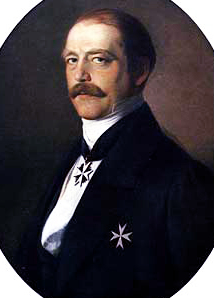
The Royal Prussian Order of Saint John was an order of merit in the Kingdom of Prussia. It was set up in 1812 and was awarded until the inauguration of the modern Order of Saint John in 1852.

The Principality of Heitersheim was an imperial estate of the Holy Roman Empire from 1548 until 1806. It was a territory of the Knights Hospitaller consisting of several noncontiguous enclaves in the Breisgau. It was a member of the Upper Rhenish Circle. Before its expansion in 1803, it had an area of about 4 square Reichsmeilen and a population of about 5 000.

The Hospitaller commandery of Saint-Jean-d'Acre is a monumental complex founded by the Order of St. John of Jerusalem, also known as the Knights Hospitallers. It is located in the city of Saint-Jean-d'Acre. In the 13th century, the commandery became the headquarters of the Order until the fall of the city in 1291.
